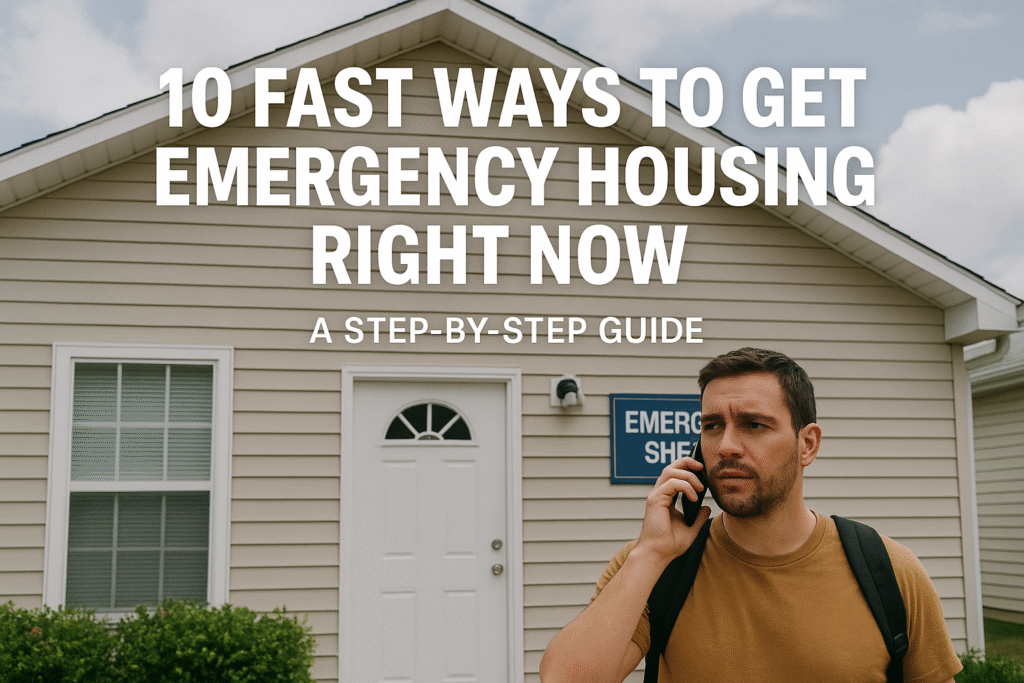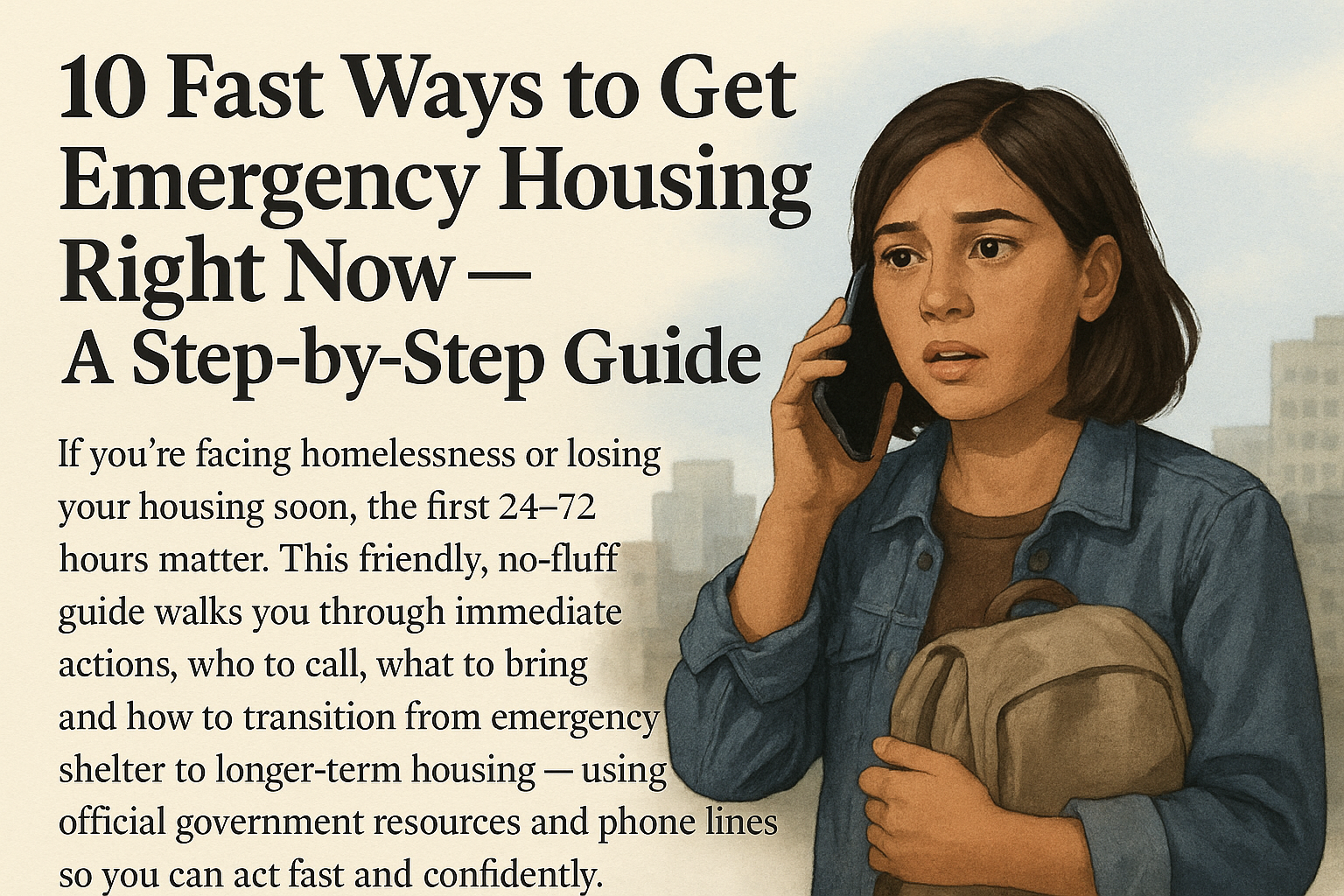Get Emergency Housing: If you’re facing homelessness or losing your housing soon, the first 24–72 hours matter. This friendly, no-fluff guide walks you through immediate actions, who to call, what to bring, and how to transition from emergency shelter to longer-term housing — using official government resources and phone lines so you can act fast and confidently.
First things first — immediate actions (do these now)
- Call 211. Dialing 211 connects you to a local operator who can immediately find nearby shelters, crisis housing, food, and financial help in 180+ languages. If 211 is not available in your area, the operator will provide local alternatives. This is the fastest single step to find emergency housing now. (211)
- If you’re a veteran, call the VA National Call Center for Homeless Veterans: 1-877-4AID-VET (1-877-424-3838). It’s free, confidential, and available 24/7 — trained counselors will connect you to local VA housing programs and emergency shelter options. (Veterans Affairs)
- If you’re a youth or teen, call the National Runaway Safeline: 1-800-RUNAWAY (1-800-786-2929) or visit 1800RUNAWAY.org for chat and text options — they provide immediate, nonjudgmental help and can arrange safe transportation or shelter referrals. (Administration for Children and Families, 1800RUNAWAY.ORG)
- Use HUD’s Find Shelter tool online. Enter your ZIP code and get a list of nearby shelters, warming/cooling centers, and local homeless service providers (useful if phone lines are busy). (HUD)
Step-by-step: How to secure emergency housing today
Step 1 — Make the calls in this exact order
- Dial 211 (or visit 211.org) to locate walk-in shelters, motel vouchers, or emergency beds near you. 211 will also connect you with local non-profits that provide immediate hotel/motel assistance in some areas. (211)
- If you’re a veteran, call 1-877-424-3838 for dedicated VA support and rapid referral to VA programs. (Veterans Affairs)
- Teens and youth should call 1-800-RUNAWAY for safe options and transport help. (Administration for Children and Families, 1800RUNAWAY.ORG)
Step 2 — Be ready with the basics (helps speed intake)
When you call or arrive at a shelter, have this info ready:
- Full name and ID (if available)
- Any family members/children with you (names and ages)
- Any immediate medical needs or mobility issues
- The last address and landlord contact (if eviction is current)
- Whether you have pets (some shelters have pet-friendly options or referrals)
If you don’t have ID, don’t delay — shelters often accept walk-ins and have procedures for people without documents.
Step 3 — Ask about types of emergency help
211 and HUD partners can refer you to different options:
- Overnight shelter / emergency bed (immediate, short-term)
- Hotel or motel voucher (used when shelters are full or for special needs)
- Transitional housing (longer stays with case management)
- Rapid re-housing or Emergency Housing Vouchers (EHV) — programs that move people quickly into rental housing with time-limited rental assistance. Ask your caseworker about EHV referrals through local Public Housing Agencies or Continuums of Care. (HUD)

Special help: youth, veterans, and households with children
- Youth & teens: The National Runaway Safeline is specifically trained to help youth find safe, short-term housing and transport options. They can also connect you to local runaway and homeless youth shelters and programs. (Administration for Children and Families, 1800RUNAWAY.ORG)
- Veterans: The VA coordinates programs (HUD-VASH, SSVF, emergency shelters) and a 24/7 call center to triage urgent needs and provide case management toward permanent housing. If you’re a veteran, call 1-877-424-3838 now. (Veterans Affairs)
- Families with children: Tell the intake worker about children immediately — many programs prioritize families for motel vouchers, family shelters, or rapid re-housing. Ask about childcare referrals and school enrollment help for kids.
How Emergency Housing Vouchers (EHV) can help you shift from shelter to a home
Emergency Housing Vouchers are a federal tool that helps Public Housing Agencies and local Continuums of Care place people from shelters or the streets into private rentals, with rental assistance and supportive services. If you’re in shelter, ask your case manager whether your community has open EHV slots and if you qualify — this program can move you into housing much faster than waiting for regular vouchers. (HUD)
What to expect at intake — be prepared so you don’t get turned away
- Screening questions: intake staff will ask about household size, health or safety needs, and whether you’re fleeing domestic violence (which can change placement options).
- Documentation: not always required for initial entry — but have whatever you can (ID, medical cards, proof of children) to speed access to services.
- Case management: many shelters assign a caseworker who helps you apply for rental assistance, benefits, and housing programs — keep their contact info and follow up weekly.
Longer-term moves after emergency shelter
- Ask about Rapid Re-Housing (RRH): RRH programs offer short-term rental help and case management to get you back into independent housing quickly. 211 and your shelter case manager can refer you. (211, hudexchange.info)
- Contact your local Public Housing Agency (PHA): PHAs administer vouchers and housing resources. HUD publishes PHA contact info so you can ask about waitlists, emergency programs, and referrals. (HUD)
- Apply for benefits: SNAP, Medicaid, and other supports help stabilize your situation while you search for permanent housing.

Safety tips & rights
- If you are fleeing domestic violence, tell the intake worker — many shelters provide confidential, priority placements and safety planning.
- You cannot be denied emergency shelter for not having ID in most jurisdictions — insist on being served and ask to speak with a supervisor if you encounter barriers.
- Keep records: note names, phone numbers, and the date/time of any referrals or promises for follow-up.
Quick checklist — copy, call, and act
- Call 211 now to find emergency housing and resources. (211)
- If veteran, call 1-877-4AID-VET (877-424-3838) for VA help. (Veterans Affairs)
- If youth/teen, call 1-800-RUNAWAY for immediate support and safe transport. (Administration for Children and Families)
- Use HUD’s Find Shelter tool online to locate local shelters and services. (HUD)
- Ask about Emergency Housing Vouchers (EHV), Rapid Re-Housing, and PHA help. (HUD)
Official, clickable resources (go here to verify or act)
- USA.gov — Get emergency housing: https://www.usa.gov/emergency-housing. (USAGov)
- 211 (United Way) — call or search local resources: https://www.211.org/. (211)
- HUD — Find Shelter tool: https://www.hud.gov/findshelter. (HUD)
- National Runaway Safeline — youth help: https://www.1800runaway.org/ (call 1-800-RUNAWAY). (1800RUNAWAY.ORG)
- VA — National Call Center for Homeless Veterans (24/7): https://www.va.gov/homeless/nationalcallcenter.asp (call 1-877-424-3838). (Veterans Affairs)
- HUD — Emergency Housing Vouchers (EHV) overview: https://www.hud.gov/helping-americans/housing-choice-vouchers-emergency. (HUD)
- HUD — PHA contact information (find local public housing agency): https://www.hud.gov/contactus/public-housing-contacts. (HUD)
Disclaimer: This guide is for informational purposes only and is not legal advice. Program availability, eligibility rules, and contact numbers change over time — always verify details with the official links above or by calling 211, the VA call center, or your local HUD/PHA office. All images used in this article are royalty‑free or licensed for commercial use and are provided here for illustrative purposes.
